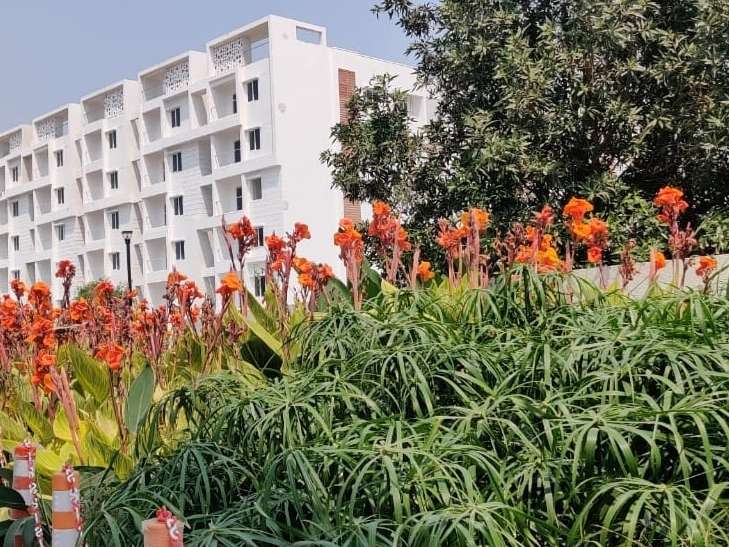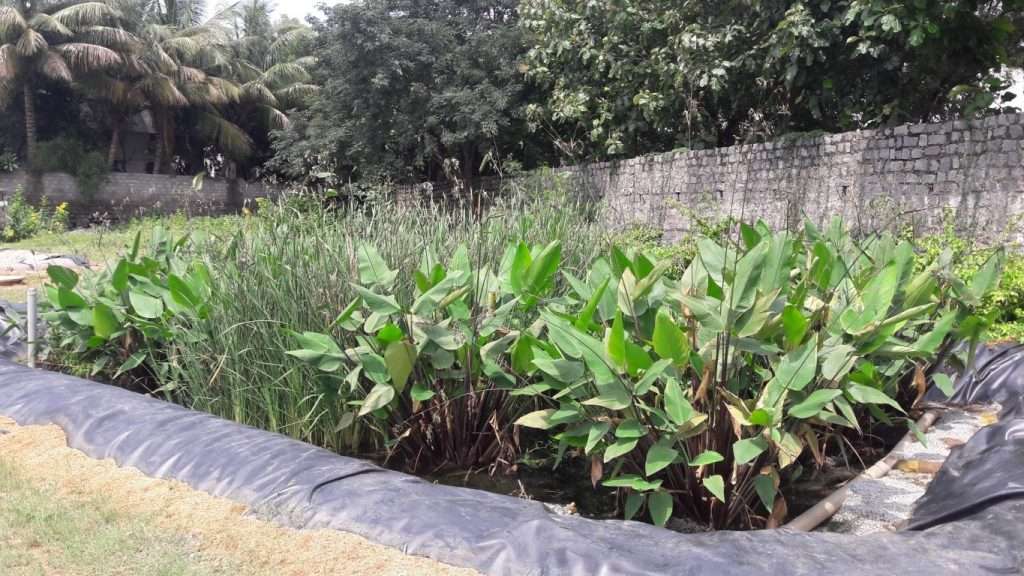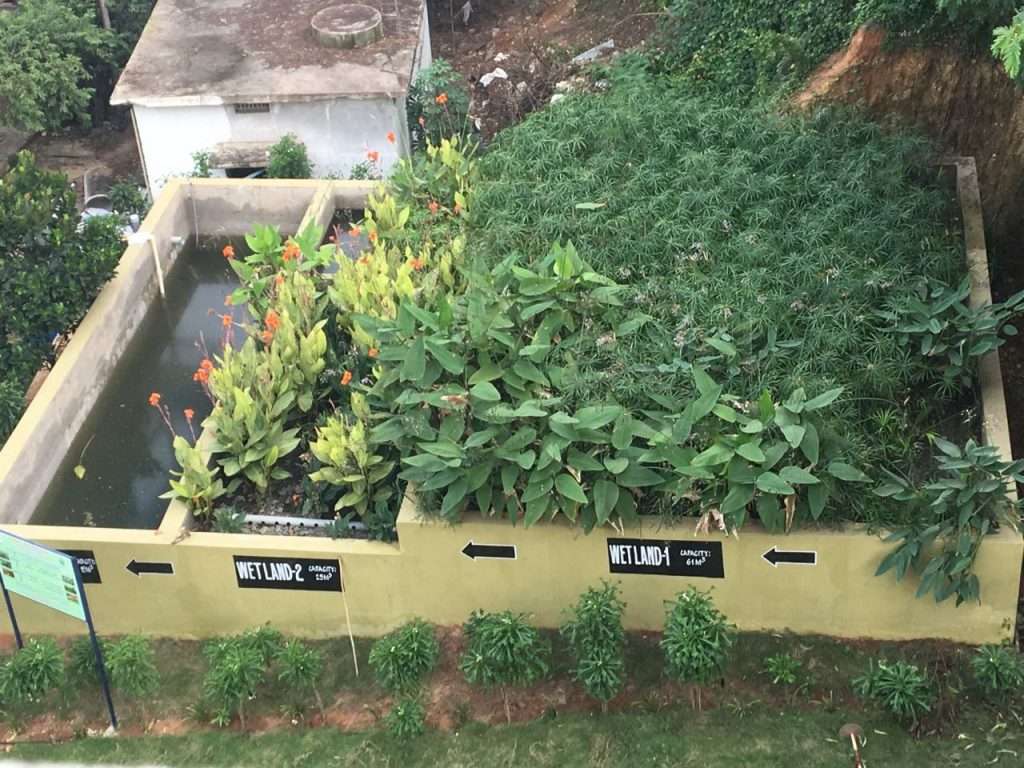BlueDrop’s Sustainable Aerated Wetland Sewage Treatment Plant & Effluent Treatment Plant Wastewater treatment Systems that commonly known as Wetland STPs & ETPs the best alternative to the Electro-Mechanical systems such as SBR, MBR and MBBR.
Advantages of Aerated Wetland STP’s

BlueDrop’s Aerated Wetland Sewage Treatment Plants saves 80% of Operational cost and 90% of energy cost. BlueDrop Forced Bed Aerated CW STP’s, a new technology in sewage treatment successfully serving various customers countrywide saving environment & treatment costs. The most economical & effective Wastewater Treatment systems which has 30 years life cycle with superior performance.
Aerated Wetland STP/ ETP are sustainable and affordable Sewage Treatment Systems for reducing environmental contamination and restoring water quality.
The system helps to remove a wide variety of pollutants from wastewater such as…


There are several types of Constructed Wetlands. Based on oxygen transfer mechanism; there are two types of CWs:
BlueDrop’s Enviro’s Constructed Wetland System has been recognized as promising system in comparison with other conventional sewage treatment technology.
The reasons are:
Zero (Passive Wetlands) to minimal electricity (Aerated Constructed Wetlands) required to run the Constructed wetlands STP. The low energy requirement in the CWs helps preserves the natural resources which further minimizes the pollution through burning of fossil fuels thus lowers the greenhouse gases level in the environment.
What is the Manpower requirement to run the Constructed Wetland STP?
BlueDrop Enviro’s CW STP does not require any skilled Manpower. Least mechanical operations and no breakdowns reduces the cost of O & M.
A part time gardener can look for the maintenance of our system.
Our system required less than 1 sq. meter for 1 KLD of wastewater treatment.
Bluedrop Enviro’s Constructed Wetland STPs has the effective life of 30 years or even more due to advanced technology. This life span is double to triple life span compared to conventional (SBR/MBBR) systems. This life span leads to huge savings.
The major components of BlueDrop Enviro’s Constructed Wetlands system consists of carefully chosen water plants species based on the specific region climatic conditions (Phragmites Australia, Typha Latifolia etc.) and media (sand, gravel, saw dust, biochar etc.). Both these components act as a filter and plays important role in removing suspended solids, organic matter, nutrients, trace elements and pathogens from municipal sewage.
In our Constructed wetland STP’s bioconversion of pollutants takes place by natural physical, chemical and biological processes such as photorespiration, photosynthesis, mineral weathering, microbial degradation etc.
BlueDrop Enviro designers and engineers carefully design each project based on the inlet capacity and purpose of reuse of treated water.
When sewage enters the wetland basin removal of solids takes place through sedimentation process. Removal of organic matter, nutrients and larger particles are naturally broken down by microbes and the plants species in the wetland basin. Heavy metals removal takes place by absorption and adsorption in the root system of plants. Pathogenic removal takes place by takes place through sedimentation, filtration, natural die off, predation and disinfection (Chlorination, UV and ozonation) process.
After treatment the water can be used for various purpose such as irrigation, gardening, and other recreational purpose. The treated water can also be discharged to surface water due to its high quality as per discharge standards. Therefore, CWs can be considered as a techno-economically feasible and affordable natural treatment system for municipal sewage treatment.
Once intwoor three based on the capacity and nature of the inlet water.
Defunct STPs what can be done?
Studies showed that around 70% of the wastewater is directly being discharged into the water bodies without treatment. The existing sewage treatment facility in India has been compromised due to poor operation and maintenance practices. Most of the sewage treatment plants are dysfunctional due to lack of skilled personnel, lack of energy sources, poor operation and maintenance (O & M), even sometimes lack of influent volume makes the treatment plants to run under capacity provides effluent of low quality.
Most popular and common sewage treatment technology such as activated sludge process (ASP), sequential batch reactor (SBR), moving bed membrane bioreactor (MBBR) fails to provide effluent of desired quality due to high investment on O & M, dependency on skilled manpower due to complex design and sophisticated electro-mechanical components. The ground realities of dysfunctional conventional treatment system arebeing reflected in deteriorating surface water bodies. Therefore, in order to restore the quality of surface water bodies, it is highly recommended to treat wastewater using cost effective, easy to operate, easy to maintain wastewater treatment system (WWTS). In comparison of conventional WWTS or passive wetland systems which also tend to choke & cause bad odours, Hybrid/Aeration Integrated Constructed Wetland Systems that are being built by BlueDrop are standing out as superior alternativesto dysfunctional WWTS. These Aeration Integrated Constructed Wetland Systems ensure minimal O&M expense requiring only a part time gardener to run the show, low energy requirement, no harmful emission, no odor with added biodiversity all around.
Can existing STP Capacity be augmented / Is it possible to Retrofit the STP
Advanced & configurable design to achieve a compact footprint is the Uniqueness of BlueDrop’s capabilities. Any underperforming conventional system built on SBR or MBBR or MBR or Extended Aeration can easily be augmented by adding a small portion of BlueDrop’s Aerated Wetlands to meet PCB norms and to get the best output water quality.
Well, if retrofitting is required, we can repurpose the existing civil construction, some of the functional equipment while building compact aerated wetlands to create an all new & aesthetically pleasing Sewage or Effluent Treatment plant just the way we did for NISA (GIVE LINK TO NISA case study)
CWs is a nature-based treatment process so it requires less maintenance and also achieves its treatment efficiency even at high concentration of pollutants as macrophytes works along with microorganism to achieve effluent quality.
Master of Environmental Science (MSc.), ‘96, Wageningen Agricultural University, Holland.
Founder of Kilian Water, Holland & Owner of Kilian Water Ltd. Denmark, 2001
Kilian Water Ltd. belongs to the few firms in the world havingexperiencewithboth design, establishing, operation& maintenance of different types of constructedwetlands: horisontal flow, vertical flow, aerated and METlands ; depending on the local needs extra applications are added like recirculation, fosforremoval, infiltration, re-use, irrigation.
The primaryproductisconstructedwetland;secondarywillow-evaporationsystem. Since 2005 around 1000 systems are made in Denmark, Sweden, Bosnia, India, varyingfrom 2,5 – 1000 PE. The systemstreat water from a wide range of sources;households, industry, villages, campings and restaurants.
To contribute to the improvement and development of the wetlands, Kilian Water Ltd. workstogetherwithknowledge-based-institutes like Technologial Institute and Aarhus University. Kilian Water has been partner in severalDanish and EuropeanResearchprojects like SWINGS, HIGHWET and iMETland; fx was SWINGS an Indian-European cooperation project, where Kilian was responsible for the design at AMU (2013-2015).
Mr. Kilian has more than 20 years experience in the field of wastewater treatment. He works whole-heartedly with an open mind and with practical hands-on-work guiding both private persons, municipalities and entrepreneurs.
Mr. Wallace is the founding partner of Naturally Wallace Consulting (NWC). He is a technology expert known for his innovative, practical water treatment solutions, including winning National Engineering Excellence Awards in 2005, 2009 and 2017 from the American Council of Engineering Companies (ACEC) for pioneering wetland treatment projects.
Scott was the co-author of Treatment Wetlands, Second Edition, widely considered to be the definitive textbook on wetland treatment system design. He was also Principal Investigator for Small-Scale Constructed Wetland Treatment Systems; Feasibility, Design Criteria, and O&M Requirements for the Water Environment Research Foundation, which is now used by the United Nations as a training manual. He has designed over 250 treatment systems in 26 countries.
Significant projects which Scott has been involved in include the Fernhill Western Wetlands Project in Hillsboro, Oregon; the hydrocarbon remediation treatment wetlands in Casper, Wyoming, Wellsville, New York, and Cano Limon, Colombia; and the wetland treatment systems for deicing runoff in Buffalo, New York, Grand Rapids, Michigan, and Heathrow Airport in London.
Prior to becoming an engineer, Scott worked as a wastewater treatment plant operator, bench chemist, and field services technician. He is often engaged in projects from conceptual design through construction, start-up and commissioning. Scott spends extensive time in the field on projects in the Americas, Europe, Asia and Africa.
Sravan Banda is the Co-founder and the brain behind BlueDrop’s entry into the Environment & Sustainability space with Constructed Wetlands. He comes with a unique combination of Bachelors in Pharmacy and Masters in Environment. With great work experience in new product development and product management with Global Pharmaceutical companies followed by enterprising experience in multiple verticals, Sravan leads Company’s global R&D, technology and innovation activities. He continually evaluates the technological landscape in accelerating the Company’s customer-driven innovation agenda. Published more than 10 technical papers in international journals. He is a research Scholar in the field of Biophilia.
Mr. Gangadhara Reddy Dontireddy, known among professional circles as ‘Ganges Reddy’ is an ‘Environmental Sustainability Expert’ and is the CEO & Co-founder of BlueDrop Enviro Pvt Ltd. A Mechanical Engineer by education, he has over 22 years of industry experience of which a decade was from overseas work in the USA in the field of Information Technology. After his return to India, being passionate about environment and believing in the best practices for eco-friendly human existence, he chose to get into wastewater treatment bringing innovation & sustainability into the game to ‘Give Water a Second Life’.
Wastewater treatment has been a major concern and pain area for Govt, public and private organizations alike. His team at BlueDrop is fully focused on delivering sustainable & economical wastewater treatment solutions that are effective & environment friendly. He is also active in community building through education, training on water related subjects and providing solutions to rejuvenate polluted lakes.
He believes in personal transformation through meditation & has been a Heartfulness meditator for over two decades. He has also been a Heartfulness trainer & mentor since 2012. He has spent significant time & efforts in bringing awareness across India towards natural and sustainable wastewater treatment technologies among Govt & Private sectors as well as in addressing Social issues like polluted lakes & Nalas.
Director. Emerging Markets
Sudha K Banda, with over 20 years of industry experience across various industries is an inventor and a proven entrepreneur. As a leader in the Energy and Environment industry at BlueDrop, he is responsible for leading BlueDrop commercial operations across the emerging markets, including India, the Middle East and Africa.
Sudha K Banda serves as a member of the BlueDrop Center of Excellence developing recommendations, curriculum and technology to encourage young entrepreneurs to promote economic growth.